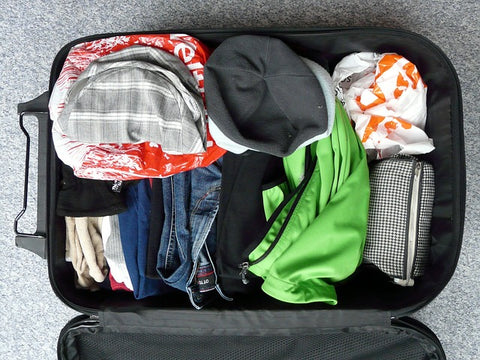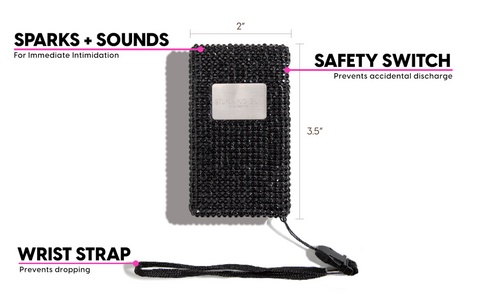Can I Take My Blingsting Stun Gun on an Airplane?
The short answer is yes, you can. However, you must check it in your luggage. In addition, if the batteries are lithium metal then they must be taken out of the device and carried on board. Check with your airline and airport to determine applicable rules. Also, be sure to check if your destination allows the use and carry of stun guns.
Table of Contents
- Can I Take My Blingsting Stun Gun on an Airplane? Essential Travel Safety Tips
- Key Points to Remember
- Traveling with a Stun Gun: Airline Rules and Regulations
- Understanding Local and State Laws
- Alternative Self-Defense Options for Travel
- Stun Gun Safety Tips for Travelers
- How to Pick the Right Stun Gun for Your Needs
- Summary
- Frequently Asked Questions
Can I Take My Blingsting Stun Gun on an Airplane? Essential Travel Safety Tips

Travelers frequently ask, 'Can I take my Blingsting stun gun on a plane?' Yes, you can, with certain restrictions. You have to put your stun gun in your checked in luggage and take out the batteries.
Here are things you need to remember when traveling by air with your stun gun.
Key Points to Remember
Stun guns, (for example, the Blingsting stun gun), are allowed in checked-in baggage while flying, yet batteries, especially lithium, should be brought separately in your carry-on per carrier and Transportation Security Administration (TSA) guidelines. It is best to contact your carrier to affirm their particular policies.
Regulations with respect to stun gun possession and transportation differ by state and sometimes to specific cities, making it crucial to research and grasp the legal regulations of airport terminals both at your point of origin and destination.
Travelers may consider alternative self-defense tools that comply more easily with travel regulations and local laws, such as personal alarm keychains, S.O.S jewelry, door stop alarms, tactical pens and heavy-duty water bottles.
Traveling with a Stun Gun: Airline Rules and Regulations

When you enter the airport with your stun gun, you should be fully aware of the specific regulations that dictate its transportation. While stun guns are indeed permitted on aircrafts, they must be nestled in your checked luggage. This is non-negotiable.
However, the path to compliance doesn’t end there. In order to avoid unexpected issues at the gate, check with your airline about their policies on electroshock weapons before you head to the airport.
Remember, most stun guns, including your Blingsting, are equipped with batteries that require special attention. If your stun gun contains lithium metal batteries, they must embark on the flight separately, in your carry-on or handcarried bag, to ensure safety and adherence to airline rules.
This is where the TSA steps in, wielding the final say on your stun gun’s passage through the checkpoint, with decisions hinging on the discretion of the individual officer. Hence, clear communication and full cooperation are key to a smooth security screening process.
Checked Luggage Requirements
Getting approval from the TSA is only the beginning; the next item on the checklist is properly packing your stun gun. According to TSA guidelines, your stun gun’s residence within your checked luggage must be secure, safeguarding against any accidental discharge. This is where thoughtful packing comes into play. Consider a hard case or a manufacturer-provided cover that snugly encases your stun gun, keeping it inactive during transit.
Moreover, it’s best to stay informed about both the airline and airport regulations as these can vary, especially when it comes to having a gun on an airplane. A brief consultation with your airline before you travel can help clarify the requirements for transporting your stun gun. This little bit of homework can prevent potential headaches and ensure that your self-defense tool doesn’t become a topic of contention at check-in.
Battery Removal
Batteries, particularly lithium metal ones, are the heartbeats of most stun guns, powering the very high voltage yet very low amps necessary to deliver that non-lethal shock. For the Blingsting Stun Gun, the -CR 123 A Lithium Batteries are its life source. However, these batteries and your stun gun must part ways before being packed, as the batteries must be removed and carried on board separately, complying with airline safety regulations.
Why such fuss over batteries? When it comes to air travel, lithium batteries are treated with kid gloves due to their potential to cause permanent physical damage if mishandled. The FAA has set guidelines that travelers must follow to prevent any risks associated with these batteries, particularly when they’re powering devices with metal prongs designed to emit an electric arc.
By adhering to these guidelines, not only do you ensure the safety of your device, but you also contribute to the overall safety of your fellow passengers.
Understanding Local and State Laws

The rules that govern your Blingsting Stun Gun can change as frequently as the scenery outside your window as you traverse state lines and time zones. Before you land in unknown territory, make sure to familiarize yourself with the rules that apply there. While stun guns are legal for civilian self-defense in the majority of states, Rhode Island is an exception - carrying such a device is illegal in RI.
State-specific rules can further complicate this legal tapestry. For instance, in states like Wisconsin, Michigan, and Illinois, owning a stun gun comes with strings attached, such as the need for a concealed carry permit or restrictions limiting use to your home or business.
Ignorance is not bliss in this case; it’s a one-way ticket to legal woes. Be savvy and ensure that your self-defense doesn’t land you in defense of your actions in a courtroom, as each state has its own laws.
Departure Location Laws
Your journey with a stun gun begins long before you step into the airport. It starts with understanding the laws at your point of departure. Some states mandate permits for stun gun possession, and without this legal shield, you may be exposing yourself to trouble. For example, residents of Illinois and Massachusetts must obtain specific licensing to legally carry a stun gun.
To navigate these regulatory waters smoothly, diligent research is key. Check local and state rules to determine applicable rules if your departure location imposes any specific permit requirements or other regulations. This not only ensures that you’re on the right side of the law but also reinforces the importance of responsible stun gun ownership.
Arrival Destination Laws
Landing at your destination with a stun gun is akin to arriving in a new world with its own set of laws. It’s important to ascertain whether the state you’re arriving in is accepting of your self-defense tool. Local ordinances can sometimes overshadow state laws, with certain cities or counties enforcing their unique regulations. Such intricacies can complicate your stay if not properly anticipated.
Thoroughly researching any additional permit requirements or restrictions for carrying stun guns at your destination is absolutely necessary. For example, states like Delaware and New Mexico have concealed carry laws that you must adhere to for legal stun gun possession. The last thing you want is for your protective measure to backfire legally, so be proactive and prepare accordingly.
Alternative Self-Defense Options for Travel

Sometimes the stars don’t align for your stun gun or pepper spray to accompany you on your travels. Perhaps the local laws are too convoluted, or the idea of parting with your lithium batteries doesn’t sit well with you. Fear not, for there are other self-defense stars in the constellation that can guide you to safety.
Personal alarm keychains, for instance, emit a startling high-decibel noise to send any would-be attacker running, with the added bonus of LED lights for visibility. There are no TSA restrictions on these personal alarms when it comes to air travel.. And let’s not forget the tactical pen, a scribe’s tool on the surface, but a formidable ally in a pinch, provided it’s packed in your checked luggage.
Stun Gun Safety Tips for Travelers
For those who navigate the legal labyrinth successfully and choose to travel with their Blingsting Stun Gun, wisdom in handling is paramount. In some jurisdictions that prohibit stun guns, it’s essential to be aware of local laws.
Like any tool of consequence, a stunning gun demands respect and awareness to prevent it from becoming a hazard. The device’s ability to shock penetrate clothing and stun gun sends an assailant into a state of shock is potent, but its efficacy can be mitigated by thick layers.
In the world of self-defense, knowing how to wield your weapon is as important as having one. With stun guns, the rule is clear: they are for self-defense only, and any misuse can land you in serious legal trouble.
When the moment of truth arrives, and you’re forced to use your stun gun, aim for areas where the shock wave will have the most impact, such as the neck or under the arms. It’s a dance of necessity, not aggression, and understanding this balance is crucial for any responsible owner.
Proper Storage

Blingsting's compact yet powerful skinny lipstick stun gun
When traveling, the importance of properly storing your stun gun cannot be emphasized enough. It’s not just about adhering to airline regulations; it’s about ensuring the safety of everyone involved, including yourself. As such, when packing your stun gun, make sure it is completely switched off, with safety features engaged to prevent any accidental activation.
The ideal place for your stun gun is within a hard container that keeps the safety switch inaccessible during the hustle and bustle of transit. This not only prevents accidental discharge but also protects your device from any potential damage. And don’t overlook the safety features your stun gun may have, like shock plates or disable pins, which are there to ensure it doesn’t turn against you.
Safe Usage
In essence, knowing how to use your stun gun safely is just as important as knowing where to pack it. The principle is simple: use it wisely and only in situations that truly call for self-defense. The shock provided by the stun gun is designed to temporarily incapacitate an attacker, targeting their nervous system and causing extreme discomfort without causing serious injury or death.
When deploying your stun gun, aim for the most effective areas – the ones where the nerves are closest to the surface. The neck, underarms, and groin area are prime targets that can help you escape a dangerous situation.
Also, rest assured when you connect with the two metal prongs on the aggressor's skin, you won't feel the shock - only they will. It's a cautious device, not a hostile weapon, and regarding that qualification is vital to both your security and your lawful standing.
How to Pick the Right Stun Gun for Your Needs

Blingsting's high voltage stun gun
Picking a stun gun can be as individual a choice as picking where to travel. There are stun guns for the individuals who prefer just the convenience oft it, fitting genuinely into a tote or pocket. Others, designed especially for ladies, opt for devices that are discreet but are also easy to use,so that they don't attract attention until required.
While looking for an stun gun, think about the following features:
- Voltage: Higher voltages might be important to infiltrate thicker clothing. Better yet, it helps to know that it is most effective on bare skin.
- Charge: A charge of 0.5µC to 1µC is by and large adequate for an impediment.
- Size and configuration: Track down the right harmony between size, plan, and ability to guarantee you feel certain and secure in your self-protection decision.
- Gap between contacts: Look at whether as a more extensive hole between contacts could upgrade your stun gun's viability.
- Battery type: Pick a battery type that is helpful and financially savvy over the long haul.
By taking into account these features, you can make a more suitable choice while buying an stun gun.
Summary
We've explored through the guidelines of flying with such a gadget, provided information regarding neighborhood and state regulations, and discussed other self-defense device options to consider aside from stun guns. Furthermore, for the individuals who truly do bring their self defense device along, we've highlighted the significance of safe storage and utilization, guaranteeing it stays a device of security, not a risk.
Keep in mind, having up-to-date information is the most important key to know which self-defense devices you can bring with you when traveling by air. Whether you're bringing a stun gun or one more type of self-defense, understanding the legalities of posession and usage, along with taking care of your self-defense gadgets will help keep you safer and more secure when traveling. Blingsting stun guns and self-defense devices is proud to have kept over 3 Million women safe, and it continues to be a quiet watchman, a careful defender, in your day-to-day activities.
Frequently Asked Questions
Can you bring a Taser on an aircraft?
Tasers, as with stun guns, can be brought on your air travel but it must be packed in your checked in baggage, and must be transported in a way that renders it inoperable from accidental discharge, hence the battery must be removed and packed separately.
What's the difference between an stun gun and a Taser?
A stun gun requires direct physical contact to convey a shock, while a Taser can be utilized from a distance of up to 15 feet by firing projectile prongs that attach to the target. This makes the Taser a more reasonable option for circumstances requiring a distance between the user and the attacker or suspect.
Are tasers and stun guns lawful in Hawaii?
Yes, TASER and stun guns are lawful for individual possession in Hawaii as of the first of January, 2022.
Is the purchase and possession of tasers and stun guns legitimate in Florida?
Yes, it is legal to purchase and carry Tasers and stun guns in Florida for individual self-defense purposes without a permit. Keep in mind though, there are limitations on posession and use in specific circumstances.
Are stun guns permitted in handcarried bags or while flying?
No, stun guns should be packed in the check in baggage while making a trip via air to follow TSA guidelines.




